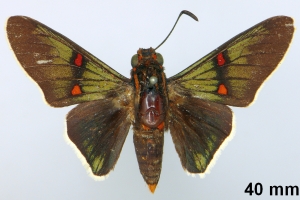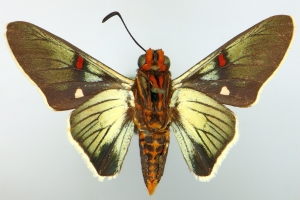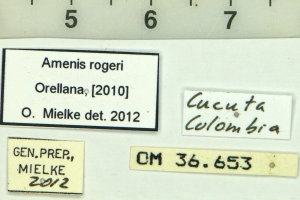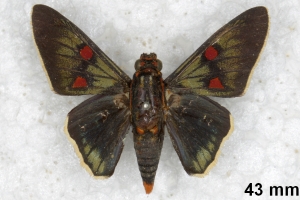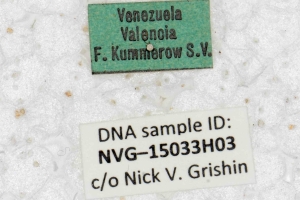2. Diagnose
2.1. Männchen
1-3: ♂, Daten siehe Etiketten (fot.: Carlos Mielke, Fotos bearbeitet: Michel Kettner), coll. Departamento de Zoologia, Universidade Federal do Paraná, Curitiba, Paraná, Brazil.
4-6: ♂, Daten siehe Etiketten (fot.: Nick V. Grishin, Fotos bearbeitet: Michel Kettner), coll. Zoologisches Museum der Humboldt-Universität zu Berlin.
3. Weitere Informationen
3.1. Faunistik
Nach Mielke, Brockmann & Mielke (2022) kommt die Art in Kolumbien und Venezuela vor.
Locus typicus: Venezuela.
(Autor: Michel Kettner)
3.2. Literatur
- Brockmann E., Mielke, C. G. C. & O. H. H. Mielke (2022): Hesperiidae III: New World Pyrrhopyginae, short text and plates. — In: E. Bauer & T. Frankenbach (ed.) (2022): Butterflies of the World 50: 40 p. + 76 pl. Keltern.
- Mielke, O. H. H., Brockmann, E. & C. G. C. Mielke (2022): Hesperiidae II: New World Pyrrhopyginae, detailed text. — In: E. Bauer & T. Frankenbach (ed.) (2022): Butterflies of the World 49: 120 pp. Keltern.
- Erstbeschreibung: Orellana, A. (“2008”) [2010]: Pyrrhopyginae de Venezuela (Lepidoptera: Hesperioidea: Hesperiidae). — Entomotropica 23 (3): 177-291. [PDF auf saber.ucv.ve]




![Vorkommen in Kolumbien [Foto im Forum]](/res/img/flag/co.gif)
![Vorkommen in Venezuela [Locus typicus. Foto im Forum]](/res/img/flag/ve.gif)
